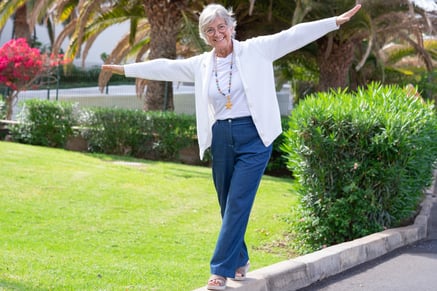 What is great about practicing balance is there are multiple ways to do so without breaking the bank. In part I of this blog series we talked about investment training tools utilizing technology but let's review three cost-effective methods regarding balance training senior living communities can implement in their programming. When participating in any type of training program, it may be important to analyze why we are implementing certain exercises. An individual may want to incorporate balance training for increased stability while moving, preventing falls from occurring, as well as ease their mind when exercising.
What is great about practicing balance is there are multiple ways to do so without breaking the bank. In part I of this blog series we talked about investment training tools utilizing technology but let's review three cost-effective methods regarding balance training senior living communities can implement in their programming. When participating in any type of training program, it may be important to analyze why we are implementing certain exercises. An individual may want to incorporate balance training for increased stability while moving, preventing falls from occurring, as well as ease their mind when exercising.
Balance classes or one-on-one balance prescriptions can be great opportunities for residents to improve their stability and confidence and these budget-friendly solutions can provide significant variety with the right fitness specialist knowing how to program them safely with participants.
- Paper Plates or Foot Slides – Paper plates are known for eating with, did you know they can be used to train our balance as well? When utilizing paper plates, individuals have the ability to practice unilateral movements at the lower extremity. Practicing unilateral movements falls under balance training due to our legs holding a portion of our bodyweight as we exercise. An individual places one foot on the paper plate and their other foot stays planted on the ground. Once in position, the individual moves the foot that is on top of the paper plate causing the paper plate to move. An advantage paper plates have over foam pads is the ability to move in multiple planes of motion as well! Foot slides are another option with these types of movements. One key difference is that foot slides are not nearly as wide as paper plates for foot placement, requiring more precision for an individual to utilize once they reach a comfortable level with their balance. With this precision, comes more effort required from the individual when moving in any plane of motion.
- Foam Pads – Utilizing foam pads is a popular cost-effective method to training balance. One key difference foam pads have is their unstable surface compared to the stability of the floor. As soon as an individual takes their initial step on to the foam pad, they may notice immediately that their ankles are having to work to keep them upright as well as balance on the foam pad. Foam pad implementation may drive a significant increase in tendon health at the ankle joint as well as tolerance for keeping our balance for future reference. An advantage that foam pads have over foot slides is that foam pads can be started bilaterally opposed to unilaterally making it applicable for beginners looking to improve their balance!
- Masking Tape – This may be the most cost-effective and versatile option of them all. Placing tape on the ground in ladder formations or different grids for a variety of stepping patterns can be highly effective for weight shifting, coordination, and footwork exercises. It can provide wonderful visual cues on where you want the participant to step and with it being flush to the ground, it doesn’t pose a tripping hazard as other equipment might where you are stepping on a disc or foam pad. Again, the right ingenuity by a qualified fitness professional can help this inexpensive “tool” go a long way in training options with residents.
Join us during Falls Prevention Week as we help communities across the country host our Empowerment Workshop giving the confidence to residents by providing the tools and resources they need to get up from a fall. Learn more about how your community can host this FREE Program here!

